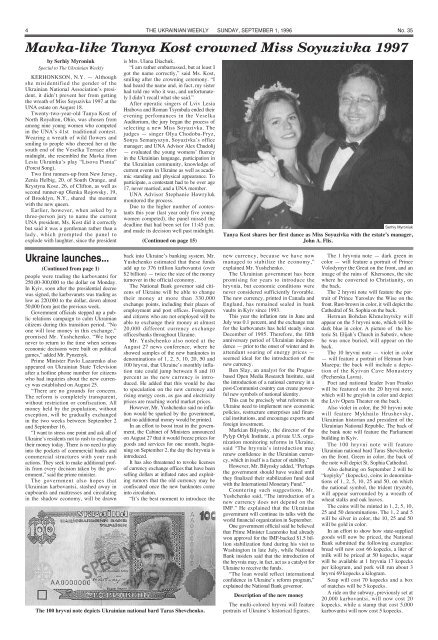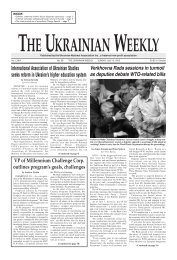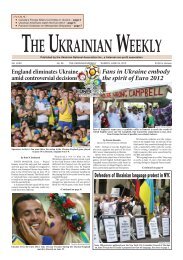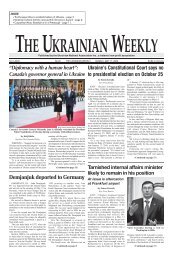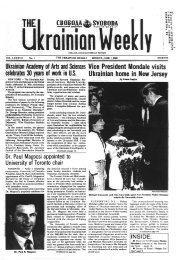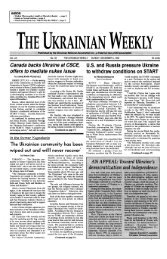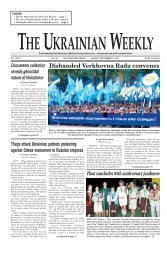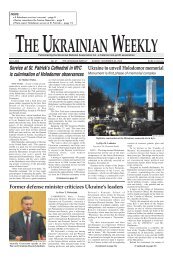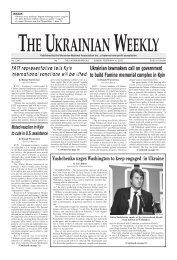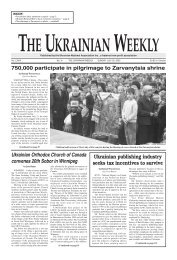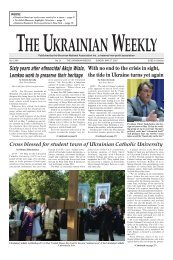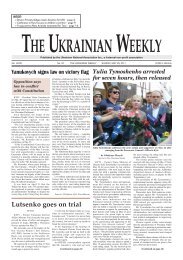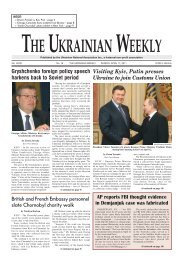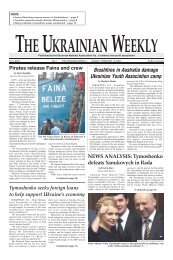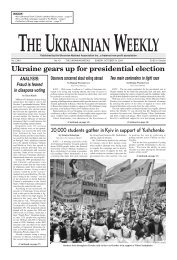Published by the Ukrainian National Association Inc
Published by the Ukrainian National Association Inc
Published by the Ukrainian National Association Inc
Create successful ePaper yourself
Turn your PDF publications into a flip-book with our unique Google optimized e-Paper software.
4 THE UKRAINIAN WEEKLY SUNDAY, SEPTEMBER 1, 1996<br />
No. 35<br />
Mavka-like Tanya Kost crowned Miss Soyuzivka 1997<br />
<strong>by</strong> Serhiy Myroniuk<br />
Special to The <strong>Ukrainian</strong> Weekly<br />
KERHONKSON, N.Y. — Although<br />
she misidentified <strong>the</strong> gender of <strong>the</strong><br />
<strong>Ukrainian</strong> <strong>National</strong> <strong>Association</strong>’s president,<br />
it didn’t prevent her from getting<br />
<strong>the</strong> wreath of Miss Soyuzivka 1997 at <strong>the</strong><br />
UNA estate on August 18.<br />
Twenty-two-year-old Tanya Kost of<br />
North Royalton, Ohio, was chosen from<br />
among nine young women who competed<br />
in <strong>the</strong> UNA’s 41st traditional contest.<br />
Wearing a wreath of wild flowers and<br />
smiling to people who cheered her at <strong>the</strong><br />
south end of <strong>the</strong> Veselka Terrace after<br />
midnight, she resembled <strong>the</strong> Mavka from<br />
Lesia Ukrainka’s play “Lisova Pisnia”<br />
(Forest Song).<br />
Two first runners-up from New Jersey,<br />
Zenia Helbig, 20, of South Orange, and<br />
Krystyna Kosz, 26, of Clifton, as well as<br />
second runner-up Olenka Rojowsky, 19,<br />
of Brooklyn, N.Y., shared <strong>the</strong> moment<br />
with <strong>the</strong> new queen.<br />
Earlier, however, when asked <strong>by</strong> a<br />
three-person jury to name <strong>the</strong> current<br />
UNA president, Ms. Kost did it correctly<br />
but said it was a gentleman ra<strong>the</strong>r than a<br />
lady, which prompted <strong>the</strong> panel to<br />
explode with laughter, since <strong>the</strong> president<br />
is Mrs. Ulana Diachuk.<br />
“I am ra<strong>the</strong>r embarrassed, but at least I<br />
got <strong>the</strong> name correctly,” said Ms. Kost,<br />
smiling after <strong>the</strong> crowning ceremony. “I<br />
had heard <strong>the</strong> name and, in fact, my sister<br />
had told me who it was, and unfortunately<br />
I didn’t recall what she said.”<br />
After operatic singers of Lviv Lesia<br />
Hrabova and Roman Tsymbala ended <strong>the</strong>ir<br />
evening perfomances in <strong>the</strong> Veselka<br />
Auditorium, <strong>the</strong> jury began <strong>the</strong> process of<br />
selecting a new Miss Soyuzivka. The<br />
judges — singer Olya Chodoba-Fryz,<br />
Sonya Semanyszyn, Soyuzivka’s office<br />
manager; and UNA Advisor Alex Chudolij<br />
— evaluated <strong>the</strong> young womens’ fluency<br />
in <strong>the</strong> <strong>Ukrainian</strong> language, participation in<br />
<strong>the</strong> <strong>Ukrainian</strong> community, knowledge of<br />
current events in Ukraine as well as academic<br />
standing and physical appearance. To<br />
participate, a contestant had to be over age<br />
17, never married, and a UNA member.<br />
UNA Advisor Stephanie Hawryluk<br />
monitored <strong>the</strong> process.<br />
Due to <strong>the</strong> higher number of contestants<br />
this year (last year only five young<br />
women competed), <strong>the</strong> panel missed <strong>the</strong><br />
deadline that had been set for 11:45 p.m.<br />
and made its decision well past midnight.<br />
(Continued on page 15)<br />
Serhiy Myroniuk<br />
Tanya Kost shares her first dance as Miss Soyuzivka with <strong>the</strong> estate’s manager,<br />
John A. Flis.<br />
Ukraine launches...<br />
(Continued from page 1)<br />
people were trading <strong>the</strong> karbovantsi for<br />
250,00-300,000 to <strong>the</strong> dollar on Monday.<br />
In Kyiv, soon after <strong>the</strong> presidential decree<br />
was signed, <strong>the</strong> karbovanets was trading as<br />
low as 220,000 to <strong>the</strong> dollar, down almost<br />
50,000 from just <strong>the</strong> previous week.<br />
Government officials stepped up a public<br />
relations campaign to calm <strong>Ukrainian</strong><br />
citizens during this transition period. “No<br />
one will lose money in this exchange,”<br />
promised Mr. Yushchenko. “We hope<br />
never to return to <strong>the</strong> time when serious<br />
economic decisions were built on political<br />
games,” added Mr. Pynzenyk.<br />
Prime Minister Pavlo Lazarenko also<br />
appeared on <strong>Ukrainian</strong> State Television<br />
after a hotline phone number for citizens<br />
who had inquiries about <strong>the</strong> new currency<br />
was established on August 25.<br />
“There are no grounds for concern.<br />
The reform is completely transparent,<br />
without restriction or confiscation. All<br />
money held <strong>by</strong> <strong>the</strong> population, without<br />
exception, will be gradually exchanged<br />
in <strong>the</strong> two weeks between September 2<br />
and September 16.<br />
“I want to stress one point and ask all of<br />
Ukraine’s residents not to rush to exchange<br />
<strong>the</strong>ir money today. There is no need to play<br />
into <strong>the</strong> pockets of commercial banks and<br />
commercial structures with your rash<br />
actions. They seek to make additional profits<br />
from every decision taken <strong>by</strong> <strong>the</strong> government,”<br />
said <strong>the</strong> prime minister.<br />
The government also hopes that<br />
<strong>Ukrainian</strong> karbovantsi, stashed away in<br />
cupboards and mattresses and circulating<br />
in <strong>the</strong> shadow economy, will be drawn<br />
back into Ukraine’s banking system. Mr.<br />
Yushchenko estimated that <strong>the</strong>se funds<br />
add up to 376 trillion karbovantsi (over<br />
$2 billion) — twice <strong>the</strong> size of <strong>the</strong> money<br />
turnover in <strong>the</strong> official economy.<br />
The <strong>National</strong> Bank governor said citizens<br />
of Ukraine will be able to change<br />
<strong>the</strong>ir money at more than 330,000<br />
exchange points, including <strong>the</strong>ir places of<br />
employment and post offices. Foreigners<br />
and citizens who are not employed will be<br />
able to exchange <strong>the</strong>ir money at almost<br />
20,000 different currency exchange<br />
offices/banks throughout Ukraine.<br />
Mr. Yushchenko also noted at <strong>the</strong><br />
August 27 news conference, where he<br />
showed samples of <strong>the</strong> new banknotes in<br />
denominations of 1, 2, 5, 10, 20, 50 and<br />
100 hryvni, that Ukraine’s monthly inflation<br />
rate could jump between 8 and 10<br />
percent as <strong>the</strong> new currency is introduced.<br />
He added that this would be due<br />
to speculation on <strong>the</strong> new currency and<br />
rising energy costs, as gas and electricity<br />
prices are reaching world market prices.<br />
However, Mr. Yushchenko said no inflation<br />
would be sparked <strong>by</strong> <strong>the</strong> government,<br />
and no additional money would be printed.<br />
In an effort to boost trust in <strong>the</strong> government,<br />
<strong>the</strong> Cabinet of Ministers announced<br />
on August 27 that it would freeze prices for<br />
goods and services for one month, beginning<br />
on September 2, <strong>the</strong> day <strong>the</strong> hryvnia is<br />
introduced.<br />
It has also threatened to revoke licenses<br />
of currency exchange offices that have been<br />
selling dollars at inflated rates and exploiting<br />
rumors that <strong>the</strong> old currency may be<br />
confiscated once <strong>the</strong> new banknotes come<br />
into circulation.<br />
“It’s <strong>the</strong> best moment to introduce <strong>the</strong><br />
The 100 hryvni note depicts <strong>Ukrainian</strong> national bard Taras Shevchenko.<br />
new currency, because we have now<br />
managed to stabilize <strong>the</strong> economy,”<br />
explained Mr. Yushchenko.<br />
The <strong>Ukrainian</strong> government has been<br />
promising for years to introduce <strong>the</strong><br />
hryvnia, but economic conditions were<br />
never considered sufficiently favorable.<br />
The new currency, printed in Canada and<br />
England, has remained sealed in bank<br />
vaults in Kyiv since 1993.<br />
This year <strong>the</strong> inflation rate in June and<br />
July was 0.1 percent, and <strong>the</strong> exchange rate<br />
for <strong>the</strong> karbovanets has held steady since<br />
December of 1995. Therefore, <strong>the</strong> fifth<br />
anniversary period of <strong>Ukrainian</strong> independence<br />
— prior to <strong>the</strong> onset of winter and its<br />
attendant soaring of energy prices —<br />
seemed ideal for <strong>the</strong> introduction of <strong>the</strong><br />
new currency.<br />
Ben Slay, an analyst for <strong>the</strong> Praguebased<br />
Open Media Research Institute, said<br />
<strong>the</strong> introduction of a national currency in a<br />
post-Communist country can create powerful<br />
new symbols of national identity.<br />
This can be precisely what reformers in<br />
Ukraine need to implement new economic<br />
policies, restructure enterprises and financial<br />
institutions, and encourage exports and<br />
foreign investment.<br />
Markian Bilynsky, <strong>the</strong> director of <strong>the</strong><br />
Pylyp Orlyk Institute, a private U.S. organization<br />
monitoring reforms in Ukraine,<br />
said “The hryvnia’s introduction may<br />
renew confidence in <strong>the</strong> <strong>Ukrainian</strong> currency,<br />
which in itself is a factor of stability.”<br />
However, Mr. Bilynsky added, “Perhaps<br />
<strong>the</strong> government should have waited until<br />
<strong>the</strong>y finalized <strong>the</strong>ir stabilization fund deal<br />
with <strong>the</strong> International Monetary Fund.”<br />
Countering such suggestions, Mr.<br />
Yushchenko said, “The introduction of a<br />
new currency does not depend on <strong>the</strong><br />
IMF.” He explained that <strong>the</strong> <strong>Ukrainian</strong><br />
government will continue its talks with <strong>the</strong><br />
world financial organization in September.<br />
One government official said he believed<br />
that Prime Minister Lazarenko had already<br />
won approval for <strong>the</strong> IMF-backed $1.5 billion<br />
stabilization fund during his visit to<br />
Washington in late July, while <strong>National</strong><br />
Bank insiders said that <strong>the</strong> introduction of<br />
<strong>the</strong> hryvnia may, in fact, act as a catalyst for<br />
Ukraine to receive <strong>the</strong> funds.<br />
“The loan would reflect international<br />
confidence in Ukraine’s reform program,”<br />
explained <strong>the</strong> <strong>National</strong> Bank governor.<br />
Description of <strong>the</strong> new money<br />
The multi-colored hryvni will feature<br />
portraits of Ukraine’s historical figures.<br />
The 1 hryvnia note — dark green in<br />
color — will feature a portrait of Prince<br />
Volodymyr <strong>the</strong> Great on <strong>the</strong> front, and an<br />
image of <strong>the</strong> ruins of Khersones, <strong>the</strong> site<br />
where he converted to Christianity, on<br />
<strong>the</strong> back.<br />
The 2 hryvni note will feature <strong>the</strong> portrait<br />
of Prince Yaroslav <strong>the</strong> Wise on <strong>the</strong><br />
front. Rust-brown in color, it will depict <strong>the</strong><br />
Ca<strong>the</strong>dral of St. Sophia on <strong>the</strong> back.<br />
Hetman Bohdan Khmelnytsky will<br />
appear on <strong>the</strong> 5 hryvni note, which will be<br />
dark blue in color. A picture of <strong>the</strong> historic<br />
St. Elijah’s Church in Subotiv, where<br />
he was once buried, will appear on <strong>the</strong><br />
back.<br />
The 10 hryvni note — violet in color<br />
— will feature a portrait of Hetman Ivan<br />
Mazepa; <strong>the</strong> back will include a depiction<br />
of <strong>the</strong> Kyivan Cave Monastery<br />
(Pecherska Lavra).<br />
Poet and national leader Ivan Franko<br />
will be featured on <strong>the</strong> 20 hryvni note,<br />
which will be greyish in color and depict<br />
<strong>the</strong> Lviv Opera Theater on <strong>the</strong> back.<br />
Also violet in color, <strong>the</strong> 50 hryvni note<br />
will feature Mykhailo Hrushevsky,<br />
<strong>Ukrainian</strong> historian and president of <strong>the</strong><br />
<strong>Ukrainian</strong> <strong>National</strong> Republic. The back of<br />
<strong>the</strong> bank note will feature <strong>the</strong> Parliament<br />
building in Kyiv.<br />
The 100 hryvni note will feature<br />
<strong>Ukrainian</strong> national bard Taras Shevchenko<br />
on <strong>the</strong> front. Green in color, <strong>the</strong> back of<br />
<strong>the</strong> note will depict St. Sophia Ca<strong>the</strong>dral.<br />
Also debuting on September 2 will be<br />
“kopiyky” (kopecks), coins in denominations<br />
of 1, 2, 5, 10, 25 and 50, on which<br />
<strong>the</strong> national symbol, <strong>the</strong> trident (tryzub),<br />
will appear surrounded <strong>by</strong> a wreath of<br />
wheat stalks and oak leaves.<br />
The coins will be minted in 1, 2, 5, 10,<br />
25 and 50 denominations. The 1, 2 and 5<br />
will be silver in color, <strong>the</strong> 10, 25 and 50<br />
will be gold in color.<br />
In an effort to show how state-supplied<br />
goods will now be priced, <strong>the</strong> <strong>National</strong><br />
Bank submitted <strong>the</strong> following examples:<br />
bread will now cost 66 kopecks, a liter of<br />
milk will be priced at 50 kopecks, sugar<br />
will be available at 1 hryvnia 17 kopecks<br />
per kilogram, and pork will run about 3<br />
hryvni 69 kopecks a kilogram.<br />
Soap will cost 70 kopecks and a box<br />
of matches will be 5 kopecks.<br />
A ride on <strong>the</strong> subway, previously set at<br />
20,000 karbovantsi, will now cost 20<br />
kopecks, while a stamp that cost 5,000<br />
karbovantsi will now cost 5 kopecks.


